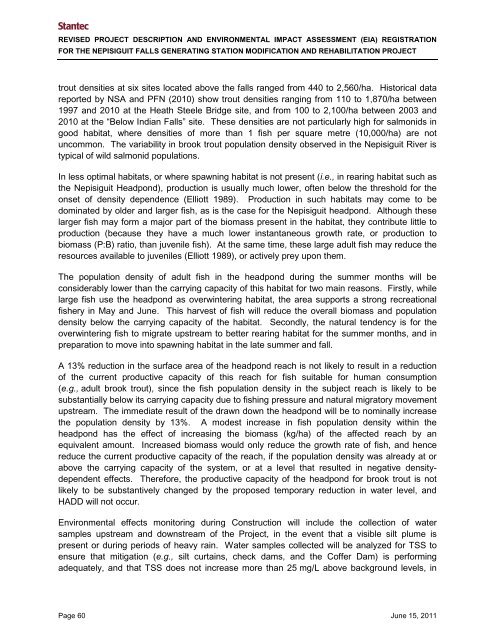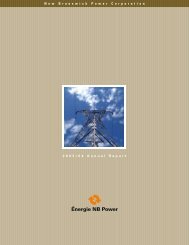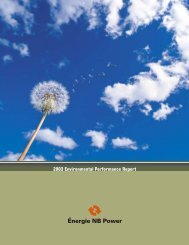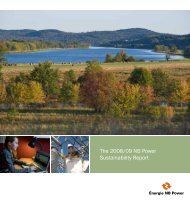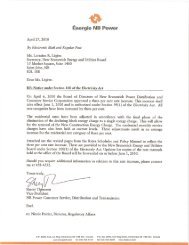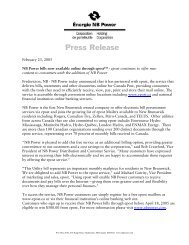Environmental Impact Assessment(EIA) Registration for the ...
Environmental Impact Assessment(EIA) Registration for the ...
Environmental Impact Assessment(EIA) Registration for the ...
Create successful ePaper yourself
Turn your PDF publications into a flip-book with our unique Google optimized e-Paper software.
REVISED PROJECT DESCRIPTION AND ENVIRONMENTAL IMPACT ASSESSMENT (<strong>EIA</strong>) REGISTRATION<br />
FOR THE NEPISIGUIT FALLS GENERATING STATION MODIFICATION AND REHABILITATION PROJECT<br />
trout densities at six sites located above <strong>the</strong> falls ranged from 440 to 2,560/ha. Historical data<br />
reported by NSA and PFN (2010) show trout densities ranging from 110 to 1,870/ha between<br />
1997 and 2010 at <strong>the</strong> Heath Steele Bridge site, and from 100 to 2,100/ha between 2003 and<br />
2010 at <strong>the</strong> “Below Indian Falls” site. These densities are not particularly high <strong>for</strong> salmonids in<br />
good habitat, where densities of more than 1 fish per square metre (10,000/ha) are not<br />
uncommon. The variability in brook trout population density observed in <strong>the</strong> Nepisiguit River is<br />
typical of wild salmonid populations.<br />
In less optimal habitats, or where spawning habitat is not present (i.e., in rearing habitat such as<br />
<strong>the</strong> Nepisiguit Headpond), production is usually much lower, often below <strong>the</strong> threshold <strong>for</strong> <strong>the</strong><br />
onset of density dependence (Elliott 1989). Production in such habitats may come to be<br />
dominated by older and larger fish, as is <strong>the</strong> case <strong>for</strong> <strong>the</strong> Nepisiguit headpond. Although <strong>the</strong>se<br />
larger fish may <strong>for</strong>m a major part of <strong>the</strong> biomass present in <strong>the</strong> habitat, <strong>the</strong>y contribute little to<br />
production (because <strong>the</strong>y have a much lower instantaneous growth rate, or production to<br />
biomass (P:B) ratio, than juvenile fish). At <strong>the</strong> same time, <strong>the</strong>se large adult fish may reduce <strong>the</strong><br />
resources available to juveniles (Elliott 1989), or actively prey upon <strong>the</strong>m.<br />
The population density of adult fish in <strong>the</strong> headpond during <strong>the</strong> summer months will be<br />
considerably lower than <strong>the</strong> carrying capacity of this habitat <strong>for</strong> two main reasons. Firstly, while<br />
large fish use <strong>the</strong> headpond as overwintering habitat, <strong>the</strong> area supports a strong recreational<br />
fishery in May and June. This harvest of fish will reduce <strong>the</strong> overall biomass and population<br />
density below <strong>the</strong> carrying capacity of <strong>the</strong> habitat. Secondly, <strong>the</strong> natural tendency is <strong>for</strong> <strong>the</strong><br />
overwintering fish to migrate upstream to better rearing habitat <strong>for</strong> <strong>the</strong> summer months, and in<br />
preparation to move into spawning habitat in <strong>the</strong> late summer and fall.<br />
A 13% reduction in <strong>the</strong> surface area of <strong>the</strong> headpond reach is not likely to result in a reduction<br />
of <strong>the</strong> current productive capacity of this reach <strong>for</strong> fish suitable <strong>for</strong> human consumption<br />
(e.g., adult brook trout), since <strong>the</strong> fish population density in <strong>the</strong> subject reach is likely to be<br />
substantially below its carrying capacity due to fishing pressure and natural migratory movement<br />
upstream. The immediate result of <strong>the</strong> drawn down <strong>the</strong> headpond will be to nominally increase<br />
<strong>the</strong> population density by 13%. A modest increase in fish population density within <strong>the</strong><br />
headpond has <strong>the</strong> effect of increasing <strong>the</strong> biomass (kg/ha) of <strong>the</strong> affected reach by an<br />
equivalent amount. Increased biomass would only reduce <strong>the</strong> growth rate of fish, and hence<br />
reduce <strong>the</strong> current productive capacity of <strong>the</strong> reach, if <strong>the</strong> population density was already at or<br />
above <strong>the</strong> carrying capacity of <strong>the</strong> system, or at a level that resulted in negative densitydependent<br />
effects. There<strong>for</strong>e, <strong>the</strong> productive capacity of <strong>the</strong> headpond <strong>for</strong> brook trout is not<br />
likely to be substantively changed by <strong>the</strong> proposed temporary reduction in water level, and<br />
HADD will not occur.<br />
<strong>Environmental</strong> effects monitoring during Construction will include <strong>the</strong> collection of water<br />
samples upstream and downstream of <strong>the</strong> Project, in <strong>the</strong> event that a visible silt plume is<br />
present or during periods of heavy rain. Water samples collected will be analyzed <strong>for</strong> TSS to<br />
ensure that mitigation (e.g., silt curtains, check dams, and <strong>the</strong> Coffer Dam) is per<strong>for</strong>ming<br />
adequately, and that TSS does not increase more than 25 mg/L above background levels, in<br />
Page 60 June 15, 2011


